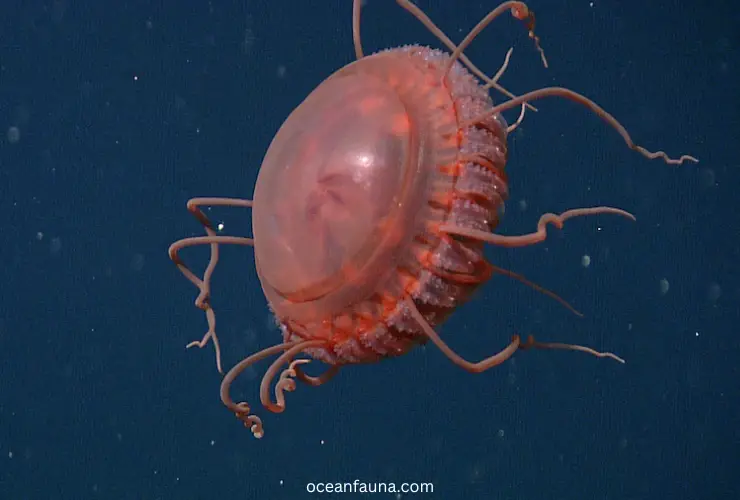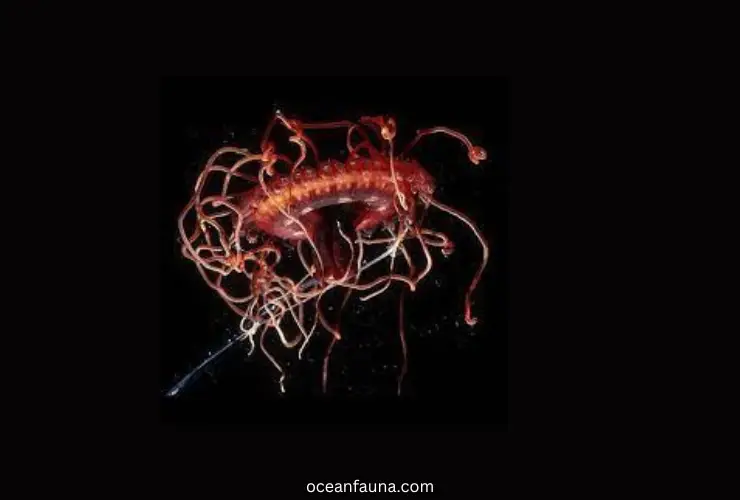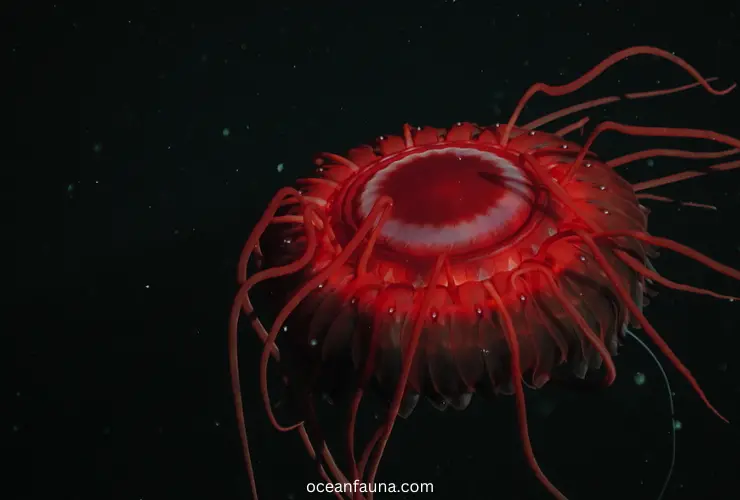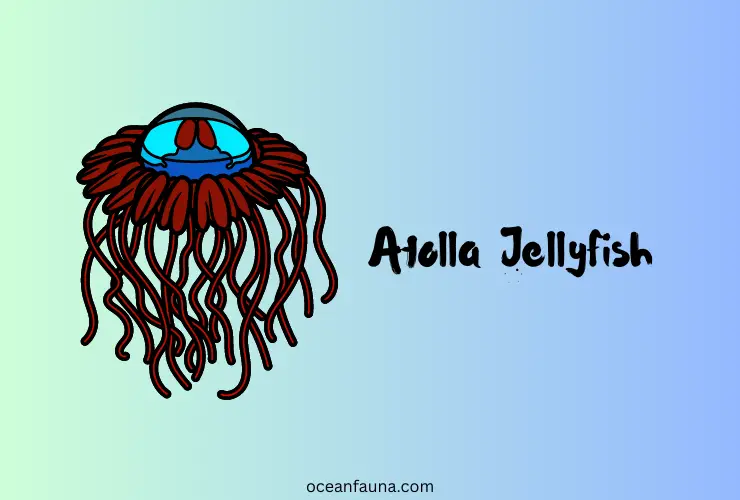Meet the Atolla Jellyfish today. It is also known as the Coronate Medusa. Atolla wyvillei is known as a deep-sea species commonly called crown jellyfish. These are found throughout the world in all oceans. These deep red-colored creatures are mid-water jellies.
Atolla wyvillei was given this name for giving credit to the chief scientist, Sir Charles Wyville Thomson. He was working on the Challenger expedition. These jellies were named after him. These fashionista jellies are intelligent enough to capture their prey. Plus, these are also bioluminescent.
Can atolla jellyfish sting humans? How do they reproduce? What does atolla wyvillei eats? There are a lot of other queries like these. We have tried to answer all the questions related to these alarming jellies. All you need to do is just back, grab a cup of coffee, and start reading their biography.
About Atolla Jellyfish – A Quick Biology
We hope this quick biology table about the magnificent atolla jellyfish will help you a lot.
| Parameters | Details |
| Scientific name | Atolla wyvillei |
| Kingdom | Animalia |
| Family | Atolidae |
| Genus | Atolla |
| Phylum | Cnidaria |
| Class | Scyphozoa |
| Order | Coronatae |
| Species | Atollidae |
| Habitat | The Atolla jellyfish inhabit the deep sea. |
| Life Span | Short life span, particularly of a few months to one year only. |
| Diet | Small crustaceans |
| Geographical range | These are found all over the world in the deep oceans and seas. |
Amazing Fun Facts About Atolla Jellyfish
Here are some fun facts about this quirky jelly:
- There are a further six species of atolla jellyfish genus. These can be distinguished from their bells.
- These sea jellies were first discovered in 1880. These last three species were discovered from 1957 to 1962.
- These jellies are known to swarm together in large groups.
- These creatures have the ability to regenerate their lost limbs.
- They are not typically kept in captivity.
- These jellyfish can be found in deep waters of 4000 feet. That’s a lot of depth.
- These atollas are able to swim with the help of water propulsion and muscle contractions.
- They can live in both warm and cold water environments.
- These are also able to change their color according to different stimuli.
- They can sense light and dark with the help of specialized structures known as ocelli.

Description of Atolla Jellyfish
Atolla jellyfish can be best described by its tentacles. It has twenty marginal tentacles. It contains only one tentacle bigger than others known as hypertrophied. This tentacle plays a vital role to catch the prey.
It lacks the following organs which are a quite freaking thing:
- Respiratory system
- Digestive system
- Circulatory system
- Central nervous system
Moreover, this jellyfish is named after the Latin word “atolla”. It means a frilly headdress, referring to its intricate and delicate tentacles.
E – Jelly Development
Edith Widder, a marine biologist, developed the E-jelly device. He was inspired by the Atolla jellyfish. The device imitates the jellyfish’s distress signals and attracts deep-sea creatures for filming.
It has proven to be successful and efficient in attracting rarely-seen animals. The E-jelly successfully lured a giant squid during an expedition funded by Discovery Channel and NHK.
The device’s mimicry was so accurate that it deceived the squid into approaching. Widder’s creation is a valuable tool for studying and documenting the elusive and mysterious creatures that inhabit the deep sea.
Anatomy / Physical Characteristics of Atolla Jellyfish
Atolla jellyfish have unique and intriguing physical characteristics. These characteristics define it as a unique sea creature. The atolla jelly has a bell-shaped body. It is 20–174 mm in terms of diameter. Also, it has eight oral arms in order to transfer food to its mouth.
According to the National Museum of Natural History, its bell-shaped body is surrounded by a frilly skirt. This skirt is surrounded by many tentacles. It is used for feeding and locomotion purposes. Its tentacles are lined perfectly with stinging cells.
These cells are known as nematocysts. These cells play an important role in capturing prey from surroundings. It has another distinctive feature known as bioluminescent ability which is quite fascinating. It can emit blue-green flashes to ward off predators.
Behaviors of Atolla Jellyfish
Atolla jellyfish exhibit the behavior of vertical migration. They can be found in deeper waters during the day. They move closer to the surface at night. This migration is believed to be related to feeding and reproduction, as well as a means of avoiding predators.
The atolla jellyfish’s ability to detect changes in light levels may play a role in this behavior. This allows them to adjust their position in the water column accordingly. Overall, vertical migration is a common behavior among many deep-sea organisms, including Atolla jellyfish. It helps them to survive in their challenging environment.

Distribution and Habitat of Atolla Jellyfish
Atolla wyvillei is distributed in all the deep oceans of this world. It primarily lives in the Pacific and Atlantic oceans. There is much evidence when you can see them resting and swimming in deep oceans.
Their depths could be 1000 to 4000 meters. This is a lot of depth. We can say that 3,300 to 13,100 feet are so deep in the oceans. This deep ocean area is commonly known as the “Midnight Zone”.
Atolla encounters extreme environmental conditions and little light. However, it can survive there. It inhabits those areas in the deep oceans where there is high availability of nutrient concentrations.
For example, upwelling zones where there are a lot of planktonic organisms. There is little information available about its distribution and behavior due to its elusive nature and deep-sea habitat.
Feeding / Diet of Atolla Jellyfish
Atolla jellyfish mainly feed on crustaceans. It has also been found to prey on floating nutrients. As we have mentioned before, this jelly can easily trap the dinner with the help of a hypertrophied tentacle. It extends its tentacles and waits for nearby prey to be caught.
After capturing prey, it then stuns the prey with stinging cells to make it immobilize. Once the prey is immobilized, it uses its oral arms to bring the food toward its mouth. Its mouth is located on the underside of its bell-shaped body. It also catches small fish and plankton to eat.
Lifespan and Reproduction System of Atolla Jellyfish
The exact lifespan of atolla jellyfish is not known yet. It is because it lives in the deep oceans and it becomes difficult to study them there. However, it is thought that the lifespan of atolla wyvillei is very short just like other sea jellies.
Its lifespan could be not more than six months to one year. During this short time, it goes through all of its life stages from tiny larvae to complete adults capable of reproduction. After its death, it sinks into the deep oceans and provides nutrients to other sea creatures.
Atolla jellyfish can reproduce in two different ways:
- Asexual reproduction
- Sexual reproduction
These marvelous jellies have the nature to reproduce asexually just like other species of sea jellies. The process to reproduce asexually is known as strobilation. In this process, the polyps develop into buds. These buds grow into larvae.
Let’s see how Atolla jellyfish reproduce sexually. The jellyfish uses its hypertrophied tentacle to attach itself to another Atolla wyvillei. It then pulls itself towards the other jellyfish to mate.
During sexual reproduction, gametes are released into the water. Fertilization occurs externally. Embryos develop into free-swimming larvae. Sexual reproduction is important to maintain genetic diversity and to adapt to changing environmental conditions.
Cardiovascular and Nervous System of Atolla Jellyfish
Atolla jellyfish have a very simple cardiovascular system. It is because it has no true heart or a circulatory system. Then how is it even alive or a living animal? Instead of this fact, nutrients and oxygen are transported through the body by diffusion.
Now come to the Atolla jellyfish’s nervous system. It does not possess a central brain just like humans or other animals. It has a decentralized nervous system. Only a few living organisms of the sea have this type of nervous system.
Its nerve cells are located all over its body instead of just a central brain. It allows the Atolla jellyfish to respond rapidly to the environment like the presence of predators and changes in light.
Adaptations of Atolla Jellyfish
Atolla jellyfish are bioluminescent. These sea jellies use a unique defense mechanism. It releases flashes of light in a series whenever it feels threatened or when attacked. These flashes attract predators towards the attacker rather than the jellyfish itself. Due to this behavior, the Atolla jellyfish has earned the nickname “alarm jellyfish”.
The light emitted by this jellyfish is blue-green in color. This light comes from photophores located on its bell. Moreover, this defense mechanism helps the jellyfish to survive and avoid being preyed upon. Scientists believe that the Atolla jellyfish have evolved this adaptation over time. It helps the jellies to protect themselves from predators in the deep sea.
Another adaptation is the Atolla jellyfish’s umbrella-shaped bell. This bell helps it to swim efficiently and catch prey. The bell contains muscles that contract and expand. This contract-expand adaptation allows the Atolla jellyfish to move forward in the water.
The tentacles of the Atolla jellyfish are also adapted for capturing prey. They are lined with stinging cells called nematocysts. These cells can immobilize small fish and plankton. The jellyfish then brings its tentacles toward its mouth to consume its prey. This is how it hunts and eats the prey.
Finally, the Atolla jellyfish have evolved to live in the deep sea. It lives there where it is very dark. Its eyes have adapted to detect bioluminescence. This adaptation allows it to find food and mates in the darkness. Overall, these adaptations help the Atolla jellyfish thrive in its unique environment.

Predators of Atolla Jellyfish
There is much evidence that shrimps and crown jellyfish are the predators of atolla jellyfish. Here is a list of other predators that love to eat these deep-ocean inhabitants:
- Sea turtles
- Some species of Seabirds
- Larger fishes
- Sea squids
- Crustaceans
According to Twilight Zone researchers, amphipods, segmented worms, and siphonophores also eat atolla wyvillei. Humans are also predators of atolla jellyfish. Some of its species are eaten by humans, especially in Japan. (Source)
However, atollas are also very intelligent in avoiding predators and refraining from eating them.
Relationship Between Atolla Jellyfish and Humans
Atolla jellyfish have very little relationship with humans. These beautiful jellies live in deep oceans and rarely encounter humans. However, the E-Jelly device is one of the best devices that was found due to inspirational atolla jellyfish behavior.
It also serves as an essential part of the deep-sea food web. In simple words, it plays a vital role to maintain the balance of the ecosystem. Despite little contact with humans, these are a subject of curiosity and fascination among marine biologists, deep-sea explorers, and oceanographers.
- There are a further six species of atolla jellyfish genus. These can be distinguished from their bells.
- These sea jellies were first discovered in 1880. These last three species were discovered from 1957 to 1962.
- These jellies are known to swarm together in large groups.
- These creatures have the ability to regenerate their lost limbs.
- They are not typically kept in captivity.
- These jellyfish can be found in deep waters of 4000 feet. That’s a lot of depth.
- These atollas are able to swim with the help of water propulsion and muscle contractions.
- They can live in both warm and cold water environments.
- These are also able to change their color according to different stimuli.
- They can sense light and dark with the help of specialized structures known as ocelli.
Atolla Jellyfish from the Waters of Japan
Once, an ROV Hyper Dolphin tried to catch and eat the Atolla wyvillei. This was filmed on the island of Japan (Izu-Oshima). However, this intelligent jelly uses its burger alarm display to threaten the dolphin. Here is evidence of this amazing behavior:
Scientists discover a new species of deep-sea crown jelly in Monterey Bay
A team of scientists from the Monterey Bay Aquarium Research Institute (MBARI) has discovered a new species of deep-sea crown jelly in Monterey Bay. This new species was named “Crown Jelly” or “Gorgopinna”. This name was given due to its crown-like tentacle arrangements. It was found during a deep-sea expedition.
The Gorgopinna jellyfish belongs to the same group of jellyfish to which atolla jellyfish belong. Its size is also the same as atolla jelly. Its bell can grow up to 7 centimeters in diameter. The unique tentacle arrangements of Gorgopinna look like a diadem. However, scientists are unsure about its specific functions.
The discovery of atolla jellyfish is very significant. It is because it shows there is still so much we do not know about these deep-sea living creatures. Overall, this discovery of the MBARI team further highlights the remarkable diversity of life in our oceans.
The Largest Blood-Red and Saucer-Like Atolla Jellyfish Ever Discovered
Scientists have discovered one of the largest crown jellyfish ever in the history of crown jellies. This discovery happened in Monterey Bay, California. It was named “Tiburonia granrojo”. This name was given due to its saucer-like weirdo shape and blood-red color.
Its body was bell-shaped and it was covered in thousands of tentacles. Its diameter was one meter and its tentacles were six meters longer. The unique color of Tiburonia granrojo was thought of as a fantastic adaptation to the low-light conditions of the deep sea.
This species was first discovered in 2003 during a remotely operated vehicle (ROV) dive. It was really a subject of interest for researchers ever since. The granrojo was believed to inhabit the deep sea at depths of 1,200 meters. Despite its large size, little information is given about its biology and behaviors.
Phthalic Acid in the Deep Aea Jellyfish Atolla
According to NCBI research, phthalic acid is found in the deep sea jellyfish Atolla. The researchers have found a shocking fact. They found that atolla jellyfish have a high level of phthalic acid as compared to any other species of sea jellies. It was found in their bells.
Basically, phthalic acid is a chemical compound that is used in the production of plastics. Its presence in deep oceans is quite surprising for researchers. The researchers have found that this acid affected the swimming behavior of Atolla jellyfish. It causes them to swim in circles rather than in a straight line.
Jellyfish-Inspired ‘Skin’ Glows When Robots Get Hurt
Atolla jellyfish has always been an inspiration for researchers all over the world. Here is another example of it. A team of researchers has developed a special ‘skin’ for robots after getting inspiration from atolla jellyfish. The skin glows when it is damaged.
This concept was taken from atolla jellyfish that glows to attract prey when it is attacked by a predator. The article’s skin was made up of a stretchy polymer material. It contains a fluorescent dye that emits light when the artificial skin material is deformed.
This feature of robots is useful in situations where robots are used in hazardous situations. It’s helpful in those situations, too, where it needs to be able to detect the damage and repair that quickly. The researchers are hoped to develop more robust and responsive technology out of it to use in different types of damage.
FAQs
Are Atolla jellyfish poisonous?
Yes. Atolla jellyfish are poisonous. These jellyfish are so poisonous that their sting on humans can cause death. Their sting can also cause severe reactions in the bodies.
It is always best to exercise caution while swimming & diving in areas where atolla jellyfish are present. Seek medical attention whenever you are stung by these poisonous creatures.
Are Atolla jellyfish rare or endangered?
There is no evidence to suggest that Atolla jellyfish are rare or endangered. These jellies are found in deep oceans all over the world.
However, due to their habitat in the deep sea, they are difficult to study and understand. More research is needed to determine their populations and conservation status.
Does an Atolla jellyfish sting hurt?
Yes. Atolla jellyfish sting can hurt you. It can leave a rash on the victim’s body. However, its sting is less painful as compared to other species of jellies. It is because its tentacle size is really short and these are thin too.
Conclusion
Atolla jellyfish are wonders of the oceans. Who knew these sea jellies could be so amazing and this much fascinating? There is no doubt left behind that these quirky creatures are gelatinous charmers of the water. So, keep your eyes out for these wacky creatures whenever you are at the beach.

